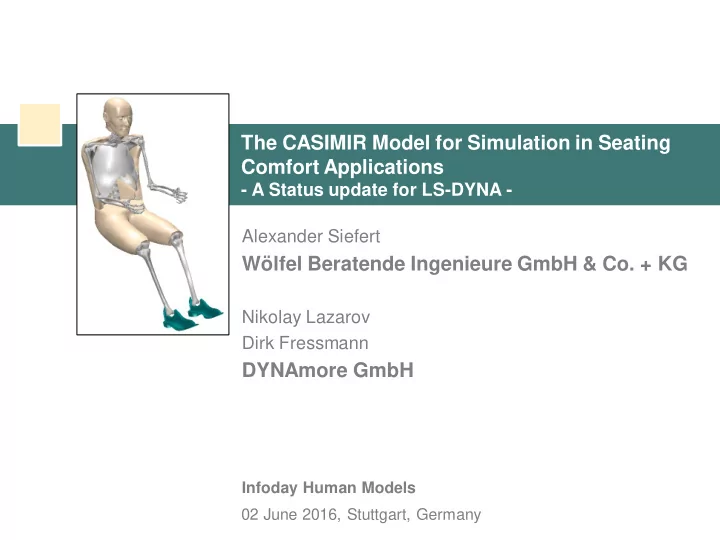

The CASIMIR Model for Simulation in Seating Comfort Applications - A Status update for LS-DYNA - Alexander Siefert Wölfel Beratende Ingenieure GmbH & Co. + KG Nikolay Lazarov Dirk Fressmann DYNAmore GmbH Infoday Human Models 02 June 2016, Stuttgart, Germany
Contents ■ Introduction to the CASIMIR model and seat development with CASIMIR/Automotive ■ LS-DYNA integration and validation process ■ Summary ■ Outlook
- Human Body Model - History ■ Initially the CASIMIR model was developed in the 1990ies at the TU Darmstadt ■ First applications were investigations with respect to the risk of occupational diseases due to whole human body exposures 1998 2015 ■ Accordingly the model included a detailed model of the lumbar spine ■ Step by step the range of application is enhanced with focus on applications in the automotive, commercial vehicle and aerospace industry
- Human Body Model - Setup Volumetric model of several types of tissue Detailed muscle approach for stabilized posture Detail model of lumbar spine and abdomen
- Human Body Model - Validation ■ The properties of the different model parts are validated in comparison to real subject or tissue test Preload in Z and loading in X Displacement [mm] Validation of lumbar spine segments via data of cadaver tests Force [N] Dynamic Behaviour – Vertical Excitation Apparent Mass [kg] Validation of dynamic behaviour via data of test with real persons Frequency [Hz]
CASIMIR/Automotive - Overview ■ Today model is the main part of a software package CASIMIR/Automotive to evaluate the seating comfort ■ There are different occupant models available Individual Percentiles Average Percentiles Average Percentiles North America Europe Asia ■ The software is currently used by Daimler, Fiat, GM, JCI and NHK
CASIMIR/Automotive - Objective ■ Using the human body model in combination with detailed seat models taking into account nonlinear and frequency dependent quantities enables a virtual seat development with increased efficiency and quality Seat pressure distribution Dynamics Statics Seated posture Meat-to-Metal Input packaging Seat Transmissibility
LS-DYNA integration and validation process
The CASIMIR model in LS-DYNA ■ CASIMIR/Automotive currently only available for ABAQUS ■ First steps of the translation to LS-DYNA ■ Model setup ■ Rigid body chain with joints ■ Special stiffness definition of the lumbar spine ■ Deformable tissue ■ Springs and dampers representing the muscles ■ Converted human body model validated on a simplified seat ■ Implicit solution schemes ■ Static non-linear seating procedure ■ Subsequent eigenvalue analysis
The CASIMIR model in LS-DYNA ■ Seating simulation performed under gravity loading ■ Segment-based mortar contact with friction between CASIMIR and seat ■ For validation purposes, three different cases have been investigated: ■ Case 1 - elastic materials of both human body tissue and seat foam ■ Case 2 - non-linear material behavior of the tissue but linear material for the foam ■ Case 3 - non-linear materials of both human body tissue and seat foam
Case 1 – All linear materials ■ Von Mises stress distribution on the seat in MPa LS-DYNA ABAQUS ■ Seat contact pressure distribution in N/mm 2 LS-DYNA ABAQUS
Case 1 – All elastic materials ■ Seat contact nodal normal force in N LS-DYNA ABAQUS ■ Difference at the peaks of the contact normal pressure ■ Almost identical results for the contact nodal normal force both solvers provide the same output difference in the contact normal pressure due to not equal projection approaches of the contact definitions and due to different post-processing
Case 2 – Nonlinear pelvis tissue, linear seat foam material ■ Von Mises stress distribution on the seat in MPa LS-DYNA ABAQUS ■ Seat contact pressure distribution in N/mm 2 LS-DYNA ABAQUS
Case 3 – All non-linear materials ■ Von Mises stress distribution on the seat in MPa LS-DYNA ABAQUS ■ Seat contact pressure distribution in N/mm 2 LS-DYNA ABAQUS
Eigenvalue and eigenmode evaluation ■ Eigenvalues of the already seated model extracted and evaluated as further validation criteria ■ Eigenmode comparison also considered as model quality check ■ The first 15 eigenvalues taken into account in the range of 0 ~ 6.5 Hz ■ Results of case 2 omitted due to similarity to Case 1 Case 1 Case 3
Eigenvalue and eigenmode evaluation ■ Samples of the eigenvectors for the eigenvalue 8# near 4 Hz ■ Pre-stresses and deformations considered by both solvers ABAQUS LS-DYNA
CASIMIR/Automotive for LS-DYNA ■ The pre-processing is currently implemented in HyperMesh using a plugin menu ■ The adaption of the posture can be carried out by the Posture Manager
CASIMIR/Automotive for LS-DYNA ■ The combination with an existing seat model is supported by the project manager in combination with a graphical user interface for positioning
Summary ■ The CASIMIR model for seating comfort simulations presented ■ Human body model currently converted to LS-DYNA ■ Translation and validation still in progress ■ First LS-DYNA simulations with simple seat model showed good correlation to the ABAQUS results regarding: ■ Seat stress distribution ■ Seat contact pressure distribution ■ Eigenvalues respectively eigenmodes in seated position ■ Both linear elastic and non-linear elastic behaviors of the seat foam respectively human body tissue considered
Outlook ■ Further developments in the model conversion ■ Consideration of more complex seat models ■ Frequency dependent materials ■ Extension to pre- and post-processing tools for LS-DYNA ■ Steady state dynamic analysis Frequency
Thank you for your attention! Your LS-DYNA distributor and more
Recommend
More recommend